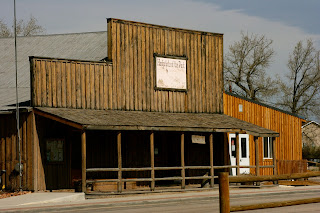A Day of Champions, Massacres, and Massacred Music
Not only are the Wyomingites friendly and courteous, but there aren't too damned many of them, either. The population is just the way I like it: close to 1.5 million cattle, and under 600,000 people. That means miles of ranch land, places where you can still hear your own footsteps, air that's worth breathing.
Twenty-six miles south of Kaycee, we pass through serene, gently sloping hillsides populated by antelope and livestock. I don't bother taking too many photos of antelope; they're like our own cottontail rabbits, always a joy to see but so prevalent that you just don't think of grabbing the camera every time you pass a congregation. This land is so quiet and tranquil it's hard to imagine the violence that swept it during the range wars of the late 1800's. This is Johnson County: site of one of the most ruthless, brutal and downright dirty range wars. Powerful cattlemen, in a horrendous turn of events, hired assassins such as Tom Horn and Frank Canton to come in and exterminate the homesteaders, whom they designated with great recklessness as "rustlers." That topic, of course, is be food for a future article; even today, the details are heartbreaking and frightening. This west wasn't just cowboys-and-Indians friction: it was cowboys versus cattlemen, Mormons versus Gentiles, foreign interests versus local homesteaders, the powerful against the oppressed.
 We pass through the area where John Tisdale, one of the early casualties of the Johnson Country troubles, was ambushed. Tisdale was assassinated in Haywood's Gulch on his way home to his family after buying winter supplies in Buffalo. The suspected killer was Frank Canton. Roadside monuments mark the site of the TA Ranch and the Tisdale Ranch.
We pass through the area where John Tisdale, one of the early casualties of the Johnson Country troubles, was ambushed. Tisdale was assassinated in Haywood's Gulch on his way home to his family after buying winter supplies in Buffalo. The suspected killer was Frank Canton. Roadside monuments mark the site of the TA Ranch and the Tisdale Ranch.Before reaching Kaycee, we cross the leisurely trickle of water called the Powder River. This land -- the Powder River Country -- was the hunting grounds of the Plains Indians -- Sioux, Cheyenne, Arapaho. Although the once-abundant buffalo are gone, we see an impressive amount of small, fat deer, untroubled by our presence. The Powder River country is also the chosen land of one of my favorite country singers, the late, great bareback rider Chris LeDoux. I'm eager to see Kaycee, where he bought his ranch and raised his family. He loved the land enough to stay there rather than live the Hollywood or Nashville lifestyle that most certainly beckoned him, and some of his lesser-known songs are ballads of the Johnson County War, and tributes to his "Powder River Home."
 |
| Copyright (c) 2013 by MJ Miller Chris LeDoux's Memorial Park |
 |
| Copyright (c) 2013 by MJ Miller Cattle Grazing Near Hole in the Wall |
 |
| Copyright (c) 2013 by MJ Miller Red Bluffs Near Hole in the Wall, Wyoming |
Nate Champion, one of the early victims of the Johnson County War, was murdered in a barn between Kaycee and Buffalo, where he bravely holed up against the "Invaders" -- Texans brought in by the all-powerful Wyoming Stock Growers' Association to kill off anyone even remotely allied with the rustlers. Nate, during his hours fending off his attackers in the KC ranch cabin, kept a journal of his final moments. Nate's notebook, unlike himself, survived as the Invaders set fire to the cabin, gunning Nate down as he fled the flames.
 |
| Copyright (c) 2013 by MJ Miller |
 |
| Copyright (c) 2013 by MJ Miller Fort Phil Kearny |
 |
| Copyright (c) 2013 by MJ Miller A Very Chilled Me on The Bozeman Trail at the Site of the Fetterman Massacre |
 |
| Copyright (c) 2013 by MJ Miller An Old Wyoming Sign Used as a Foot-Bridge Over a Gully |
 |
| Copyright (c) 2013 by MJ Miller Sweeping View from the Site of the Fetterman Massacre |
 |
| Copyright (c) 2013 by MJ Miller A Pair of Herons at the Site of the Fetterman Massacre |
Abruptly the wind stops, the clouds part, and we're treated to the most seductively lovely sunny afternoon, there on that bloody ridge overlooking indescribably beautiful hillsides. A pair of herons makes an odd chuckling noise nearby, too shy to be properly photographed.
 |
| Copyright (c) 2013 by MJ Miller Site of the Fetterman Massacre |
 |
| Copyright (c) 2013 by MJ Miller The Occidental Hotel, Buffalo, Wyoming |
Attentively renovated to resemble its original western appearance, the Occidental boasts not only that Butch Cassidy slept there, but that Owen Wister's Virginian ultimately got his man there. The restaurant attached to the hotel is called the Virginian, appropriately. We pass it up over Russ' shock at the prices on the menu, and instead stop at Up in Smoke, a barbecue joint up the street. There, a sweet and perky waitress serves us the most expensive (and least worthy) BBQ we've ever eaten. We each have a beer and a sandwich and a small dish of ice cream, and I can't help but laugh at the $50 tab. It's just plain funny that it nearly costs as much as the upper-crust fare at the Virginian may have.
 |
| Copyright (c) 2013 by MJ Miller Lobby of the Historic Occidental Hotel, Buffalo, WY |
It has been an easy day for driving; 240 miles, and every inch boasting gorgeous scenery.

























